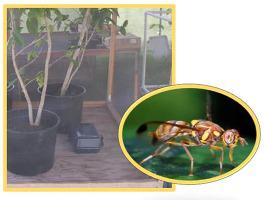Journal of Asia-Pacific Entomology ( IF 1.1 ) Pub Date : 2021-07-08 , DOI: 10.1016/j.aspen.2021.06.011 Jaime C. Piñero 1 , Steven K. Souder 2 , Dong H. Cha 2 , R. Max Collignon 2 , Roger I. Vargas 2

|
In many insect species including fruit flies (Diptera: Tephritidae), the behavioral responses to volatiles emitted by their host plants can be modulated by environmental conditions and by the physiological state of the insect. Here, we quantified (1) the effects of female age on the attraction of female melon fly, Zeugodacus cucurbitae (Diptera: Tephritidae) to volatiles emitted by intact and mechanically damaged tomato (Solanum lycopersicum), eggplant (S. melongena), zucchini (Cucurbita pepo), bitter melon (Momordica charantia), and cucumber (Cucumis sativus) fruit, and (2) the influence of time elapsed since fruit damage on the outcome. The investigations were conducted under semi-natural conditions in Hawai’i. Results from the first experiment revealed that, for freshly damaged tomato, eggplant, and zucchini, the level of female response was comparatively low and was not affected by female age. For bitter melon and cucumber, higher levels of response to freshly damaged fruit were documented, and the response levels gradually increased as female age increased from 1 to 4 weeks, reaching 70% for 4-week-old females exposed to cucumber odor. Results from our second experiment indicated that, on average, 56% of the females released responded in 20 min when cucumbers were freshly sliced, and the level of response was reduced 6-fold within a couple of hours. Females did not respond to tomato and cucumber odor when fruits were damaged >8 h before testing. Fruit volatiles involved in female Z. cucurbitae attraction seem to be released shortly upon mechanical damage and they are short-lived. The plasticity of the olfaction-driven behavior observed in Z. cucurbitae depending on female age and on the strength of the olfactory cues associated with preferred and less preferred hosts, adds another dimension to our understanding of the host-seeking behavior of this invasive species.
中文翻译:

雌性瓜蝇、葫芦科(双翅目:实蝇科)对受损寄主果实释放的挥发物的年龄依赖性反应
在包括果蝇(双翅目:实蝇科)在内的许多昆虫物种中,对寄主植物释放的挥发物的行为反应可以通过环境条件和昆虫的生理状态进行调节。在这里,我们量化了(1)雌性年龄对雌性瓜蝇、葫芦科(双翅目:实蝇科)对完整和机械损坏的番茄(Solanum lycopersicum)、茄子(S. melongena)、西葫芦(Cucurbita pepo )、苦瓜 ( Momordica charantia ) 和黄瓜 ( Cucumis sativus)) 果实,以及 (2) 果实受损后经过的时间对结果的影响。调查是在夏威夷的半自然条件下进行的。第一个实验的结果表明,对于新鲜受损的番茄、茄子和西葫芦,雌性反应水平相对较低,不受雌性年龄的影响。对于苦瓜和黄瓜,记录了对新鲜受损水果的更高水平的反应,随着雌性年龄从 1 周增加到 4 周,反应水平逐渐增加,4 周龄暴露于黄瓜气味的雌性反应水平达到 70%。我们第二个实验的结果表明,当黄瓜被新鲜切片时,平均有 56% 的雌性在 20 分钟内做出反应,而反应水平在几个小时内降低了 6 倍。当水果在测试前被损坏超过 8 小时时,雌性对番茄和黄瓜的气味没有反应。女性参与的水果挥发物Z. cucurbitae吸引力似乎在机械损坏后很快就会释放,并且它们是短暂的。在葫芦科植物中观察到的嗅觉驱动行为的可塑性取决于女性年龄以及与偏好和较不偏好宿主相关的嗅觉线索的强度,为我们对这种入侵物种的宿主寻找行为的理解增加了另一个维度。











































 京公网安备 11010802027423号
京公网安备 11010802027423号